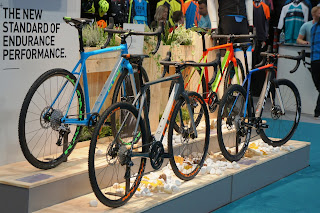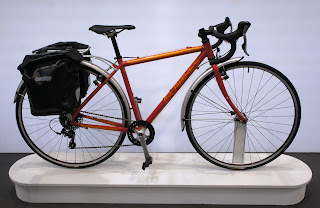Things come in threes. A
pronounced lack of braking prowess was traced to a tainted disc-easy purged
using a solvent wipe, then my fixed gear winter/trainer’s rear Schwalbe
Marathon succumbed a phantom flat.
I decided, wheel out, that
this was also time to replace the otherwise likeable KMC X1 with a budget
relative-the B1. This is a 112 link nickel plated model, which seems relatively
smooth and looks reasonably durable for now. Will look towards a heavy duty,
half-link design next time round.
The less slippery plating will
hopefully ensure lube will remain within the rollers, rather than migrating to
the side plates. Since the forecast is
unseasonably mild, I’ve gone for some Squirt wax lube. Well, it’s closer to an
emulsion, the sort that collects contaminant, then flakes off, leaving a filmy,
low friction layer behind.
Talking of layers, I’ve
reached a firm conclusion re the Crankalicious crisp frame wax https://www.sevendaycyclist.com/crankalicious-crisp-frame-wax
Since winter is hard on
everything and consumables, can get gobbled at an alarming rate, I’ve acquired
a set of Spyre pattern pads. Sods (Murphey’s if we’re being pedantic) law
dictates that the OEM pads will suddenly wear to their minimum, just when I’ve
none in! I’ve also renewed the front
Jagwire cable in favour of the Jagwire Pro-Road, since the existing set up,
though very efficient was showing signs of fraying.
Serendipity had brought this
BBB flex ribbon bar wrap to my doorstep. This is a gel impregnated
polyurethane, designed to insulate against vibration, while providing excellent
grip. The green was pot luck, chosen by windwave, their UK importer but
coordinates surprisingly well with the Upso Stirling https://www.sevendaycyclist.com/upso-stirling-seat-pack
, blue/grey livery and of course, the celeste cable.
The coming months will confirm
how good the flex ribbon, especially compared with polymers and silicones https://www.sevendaycyclist.com/genetic-silicone-bar-wrap
. The former, though very good in terms of comfort and grip, are trickier to
care for. For example, scrubbing them with a medium stiff brush dipped in a
sudsy bucket is a no-no. Assuming of course, you didn’t want to strip the
clever coating.
Reminds me, my MK1 KA’s discs
are running a little thin but I’m assured by my friendly local garage that
they’re good until the next service. Hub transmissions have always appealed on
a similarly sleek, low maintenance basis. I’ve been particularly impressed with
Shimano’s Alfine, or the iconic Rohloff.
Talking of which, this Thorn
Raven, Rohloff specific frameset arrived for makeover at Maldon shot blasting
& powder coating the other week. This one is TIG welded in Taiwan and to a
very high standard, whereas those built by Lee Cooper http://leecoopercycles.webs.com/ were impeccably fillet brazed.
Staying with bespoke, I’ve
done 200miles on John Moss’s wheel build and am really impressed both with the
spec and his skill. The Halo white line rim, is a 24mm wide “general purpose
model”; designed with gravel, touring and similar duties in mind.
The double wall, box section
T10 heat treated, low profile aluminium alloy construction, stainless steel
eyelets are the hallmarks of a strong, reliable wheel. Given the spec and
brief, Jordan at Ison distribution www.ison-distribution.com
(who also import the Shutter precision
hubs) recommended a three cross lace up, which resonates with John’s default, wheel
building pattern.
The Shutter precision PD8 disc
brake hub is available in a wealth of colours, although considerably smaller in
size, compared with more traditional hub dynamos. Inside the compact shell,
it’s a 6v 3w output. An ultra-reliable hollow cro-moly axle turns on sealed
cartridge bearings.
Turning the hub by hand,
there’s some obvious resistance but it’s still pretty unobtrusive and certainly
less than I’ve noticed with Shimano’s Ultegra. This remains so, when wired up
to a lamp and on the road. A skewer isn’t supplied but in this instance I’ve
gone for the Ultegra’s since my Univega sports a Kryptonite locking model, to
prevent opportunist pilfering.
Theft of expensive components
has become an increasingly prolific problem. That’s not to say, thieves who
haven’t been able to foil locks, or cut through street furniture, have come
away empty handed but there is a trend for targeting bars stems, forks etc.
Not just in the seamier areas
either, although slum neighbourhoods are a bad bet at any time of the day. One
option is to have your name, or similar distinguishing marks etched into the
component surface. Fine if you didn’t want to sell, or trade them on at a later
stage.
Arguably, you wouldn’t put “desirable”
higher end contact points on a working bike. Nonetheless, if it’s pretty and
non-descript an opportunist with a set of Allen keys may well indulge. Aftermarket fasteners with unique keys are
arguably the most secure option but not so good, if you’re prone to losing
stuff. If you are going this route, make sure surfaces don’t provide purchase
for pliers and other, simple brute force removal techniques.

























































